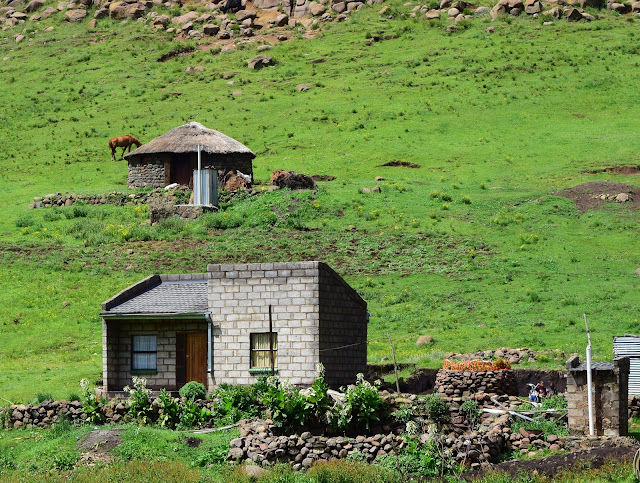I hadn't properly labeled my images from a trip to South Africa in 2015. Through editing, I've gotten used to magnifying and examining pictures--a sort of pale echo of the Photographer in Antonioni's classic film "Blow Up" which was released over fifty five years ago (the sound you hear may be me screaming in horror at the thought)...only instead of revealing a murder or an illicit affair, my photos when blown up only show some cool plants and perhaps some stories that I hadn't even noticed when I took the pictures. I took this picture of a typical roundavel--the picturesque traditional homes in Lesotho and much of South Africa not realizing there was more inside...once I "blew it up" I noticed things.
I suddenly notice a row of what I'm sure are Arizona cypress--a tree I've seen planted a lot in South Africa (and elsewhere around the world). When on earth did they get Cupressus arizonica? Who imported it? Why this and not any of the hundreds of other conifers that would thrive in Lesotho? I have a bit of history in introducing this conifer to Colorado--a story I've yet to tell in a blog--and here they are again to remind me.
And the roundavel along the road has a HUGE Kniphofia northiae--also loaded with seedpods. And a different aloe to the right of the door--perhaps A. pratensis?
Another image of an unusual cinder block house very unlike the roundavels: a more prosperous person? A rebel? And look at the masses of Nicotiana sylvestris growing out of the wall! The fragrance at night! And what is that symmetrical mound near the front door?
 |
As I zoom in to the right I see a raised bed with something growing in it: what could it be? protected by an orange mesh and look! There are three little children sitting peacefully: what's that all about? Taken six years ago, they're probably in middle school now. How's the pandemic affecting children in rural communities like this who likely don't have internet? ... the photo raises all sorts of questions for me.
A bit further down the road I see a school and snap a picture from afar. After I zoom in I see an older lady rapt on her phone, and the one on the right has been on her cell phone too (amazing how quickly cell phones have spread around the world). And the grumpy kid in the middle: what are they waiting for?
With digital cameras and phones, we can take photos with enormous detail that lets you blow them up to a huge size. Unlike David Hennings in movie, we as photographers can do this on our phones or at a desk top--no need for dark rooms and processing film nowadays. And yet how rarely we do it!
Looking at hundreds of images from Africa, I am getting homesick. As I worked on this blog post, I realized it's Black History month: Lesotho has a relatively recent historical record, but Africa is the ancestral home of all of us (or as they say at the Cradle of Mankind museum near Pretoria: "where our collective umbilical cord is buried"). We are all Africans, although some of us have lost most of our melanin in our skin (this has only been in the last few tens of thousands of years according to recent anthropological research). As rustic and exotic as these roundavels may strike us--the life of many Lesotho farmers is not that different from the first generations of North Americans who settled the West: rustic homes, big hearts and a lot of hard work. After all, the Basotho people only settled the Maloti highlands in the last few centuries (supplanting and absorbing the San people in the process--much as the American Indian was) Lesotho is frontier culture much like European settlement of Colorado. Which is why Americans may squirm a bit when we first visit.
On the several trips I've taken to Lesotho I have seen no end of floral treasures which are so well adapted to Colorado: I've passed some of the best times of my life there, and now in COVID isolation I re-enjoy these trips, seeing things I never noticed at the time! As I do so I realize Lesotho has pyroclastically blown up so many of my prejudices and preconceptions as well..












I can't figure something out in the above picture. What are the radiator like things shaped like a metal box with a white pipe sticking up? It is intriguing to see something so modern in an otherwise stone age landscape.
ReplyDeleteI think those roundavels would be an excellent addition to a rock garden. Especially one based on South African plants.
James James James: I've enjoyed your comments for years, but none more than this! Those are no less than Basotho PRIVVIES! Not that different from the outhouses that were Universal in America as well a hundred years (or more depending on where you lived) ago! You did set me up for that one!
ReplyDeleteIt was an honest question. When I first saw the images, I thought the structures were for an electrification project or to get water. I later considered that they were outhouses only because of the pipe. It is really hard to imagine using such a small space for that purpose.
DeleteCinderblock house is probably someone who works in the city. Brings money home to build a house. When we drove to Kruger Park we saw some beautiful houses (probably inspired by a working year in the construction industry)
ReplyDelete